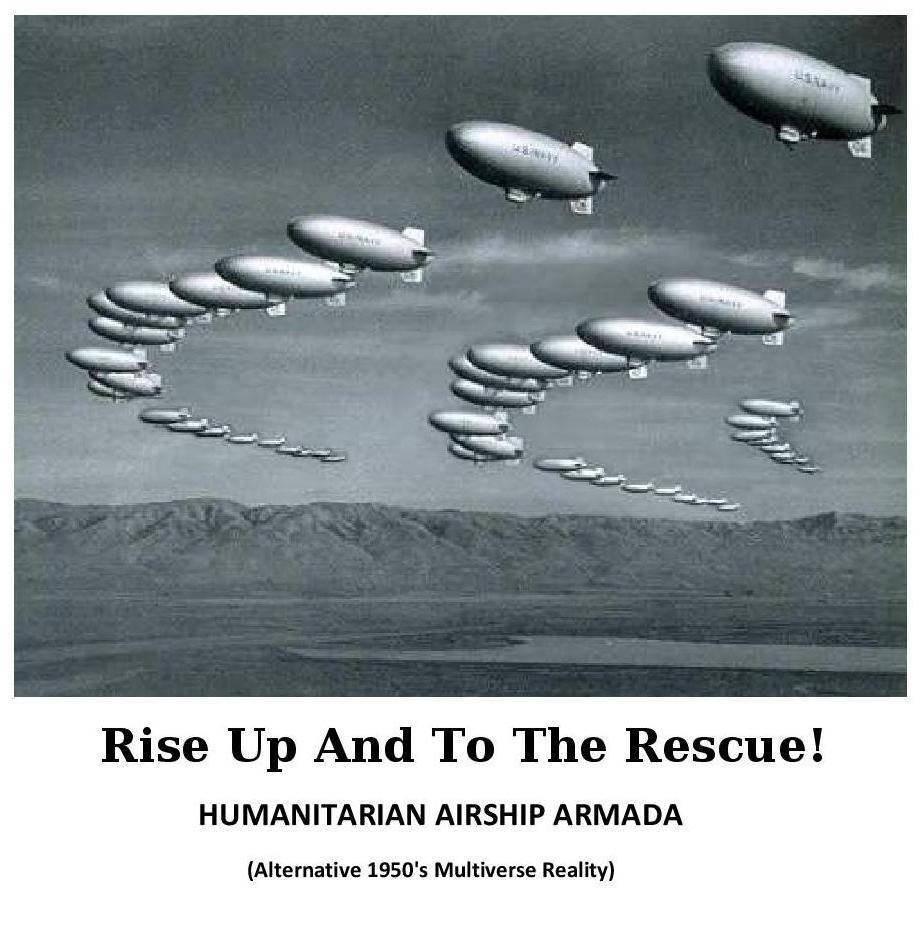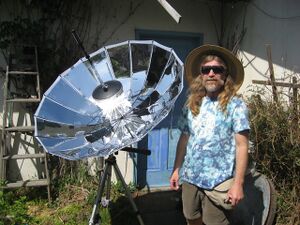
CLASS PROJECTS FOR HSU STUDENTS ENROLLED IN APPROPRIATE TECHNOLOGY-ENGINEERING 305 SPRING SEMESTER 2020. IN ADDITION, STUDENT INTERNS ENROLLED PERMACULTURE COURSES AT LOST VALLEY EDUCATION & EVENT CENTER ARE ALSO ENCOURAGED TO PARTICIPATE.
Here Are Engineering 305 Class Projects I have recently designed and tested for students to choose from and to recreate as their own class project for full credit[edit | edit source]
- The Earthen Solar Cooker
- The Parabolic Wheel of Revolution!
- The Stadium Light Reflector Wash-Basin/Water Heater
- The Willow Basket Parabolic Solar Cooker
- The Parabolic Umbrella Solar Cooker
- PROJECT: SPACE UMBRELLA [1]
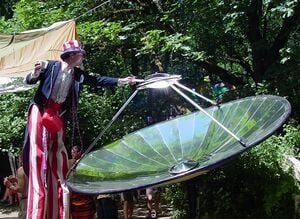
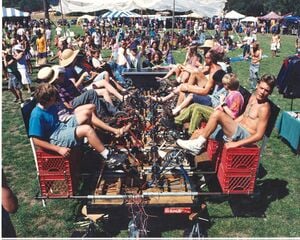
Greetings From Bart Orlando[edit | edit source]
- For the last 25 years I have volunteered as a teaching assistant, tutor and mentor for engineering students who choose to work on their class project with me. Together, we build educational appropriate technology displays which are demonstrated at renewable energy fairs, farmer's markets, at CCAT and at local schools. I share my project visions when I come to address your class early in the semester. We work together on new projects or continue work on a past project with repairs or improvements. I ask that in your project web page write up you mention that I offered up the project vision and provided consultation and/or hands on instruction. You will receive academic credit from your class instructor for assisting me in bringing one of these project visions to fruition. Students who assist me with the design and building of a project may display our work on the project at an event. Each participant brings special skills and areas of interest: computer assisted diagrams, the arts, writing, machine skills, networking, ceramics, building web sites, cooking, bike building, networking and organizing which can used to help FURTHUR a project.
- The students who work with me shoulder the cost of materials needed for fabrication of the display. SO, the nature of the project is determined by each student's skill level, their budget and ability to obtain donations of materials needed. Some projects are funded by appropriate technology education centers for whom they are commissioned. I encourage the use of surplus and used, second hand materials found in scrap yards, thrift shops and recycling centers when possible.
- Work space will be a necessity. A garage or similar setting that has electricity, running water, a restroom and a large door.
- When estimating your project time commitment, please keep in mind that a project idea which seems to be a straight forward and but a simple task, will in reality take much longer than you expect; spanning the entire semester (if not your entire life). Begin your project as soon as you can. There may be time intervals during which your project is temporarily stalled. These are opportunities for you to get assignments for other classes out of the way. Please allow for 2 weeks of testing your completed project before the class demonstration at the end of the semester. This allows time for necessary design corrections.
- When estimating the amount of time required, as well as the price materials and labor for a project you're building for a client (especially if it is your very first attempt), my advise is to overestimate the cost of materials, time and labor needed. This way you're less likely to run out of time and money. Plus, they'll be pleasantly surprised when you inform them that it took less time to complete and cost less than anticipated.
- Build your finished project to last a long time even under extreme conditions. Design it to be stronger then it needs to be, while using materials that are least likely to rust or corrode over time. Think of your project as the unshielded contents of a time capsule and a message to the distant future.
.
FEATURED PROJECTS FOR SPRING 2018[edit | edit source]
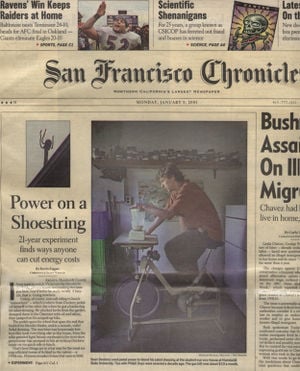
PLEASE RESTORE THE CCAT PEDAL POWERED BLENDER[edit | edit source]
Project History:
This blender was designed and built as a 1997 HSU whole earth engineering 114 project by Saramie Williams and project guide, Bart Orlando. It was featured on the front page of the San Francisco Chronicle back in March of 2001. In 2003 the first improvements in the drive line and general refurbishments were completed as another engineering 114 class project which Bart guided to completion. Further design progress was put on hold while CCAT itself was dismantled, moved and refurbished. In 2008 CCAT co-directors granted Bart's request to restore the blender after it became weathered and rusted from being stored outside for more than a year. New bearing assemblies were purchased to replace those that had rusted and the blender was disassembled for refurbishment. However the project was put on hold again for another 6 years, over which time the dissembled drive line parts went missing. CCAT has granted Bart's request that this bit of history be restored to its original condition and shall fund the replacement of those missing parts, (as well as the refurbishment/rebuilding of the weathered counter-top assemblage.)
We can begin as soon as possible with a step by step online discussion-overview of this project as well as the physics and engineering principles involved in how the blender works. This can be followed by students creating diagrams with the exact specifications of the parts to be re-fabricated. The diagrams will be presented to an experienced and professionally skilled machinist for fabrication.
For more info, please contact Lonny Grafman HSU Engineering Dept. and Linnea - CCAT Co-director and Bart Orlando - Project Advisor.
Materials Price Estimate - This project is funded by CCAT
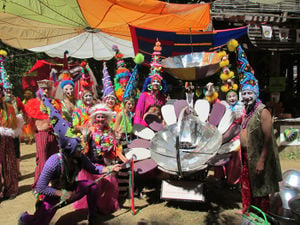
Skill Level Needed - Ideally, a person should be experienced using wrenches, ratchets, socket sets, some welding, grinding, drilling, parts assembly, wood working, bicycle assembly and familiar with what a lathe, a drill press and a milling machine are for. However, a group of students working together may share skills that the others lack. Machine parts for this project must be fabricated by a professionally skilled machinist in the Arcata area. Check with CCAT maintenance personnel to see if the Miller wire feed welder is working(and if CO2 gas and welding wire on hand). Here is a link to a web page entitled Pedal Powered Innovations which chronicles Bart's pedal power volunteer work at CCAT and with HSU engineering students for over 20 years. [2]
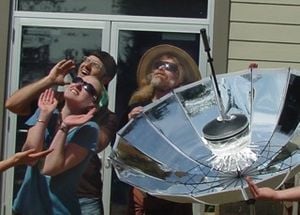
*Papasan Chair-Parabolic Solar Cooker: This project involves surfacing the concave side of the papasan chair frame with pie wedge shaped facets cut from sheets of thin mirror finished anodized aluminum. The aluminum mirror material can be obtained from Lonny at cost. The 2nd hand papasan chair frames are available at thrift shops, yard sales and on Craigslist. There are two recently published Appropedia webpage descriptions of successfully completed papasan chair-parabolic solar cookers by Engineering 305 students; they are listed as links with other past projects near the bottom of this web page. The same parabolic curve that makes the papasan chair shape strong, also allows the mirror surfaced chair frame to function as a reflective lens when pointed at the sun; focusing direct sunlight on to a black cooking pot or frying pan. It can boil a gallon of water in one hour, cook beans and brown rice, steam veggies and brown potatoes for a stir-fry. Once affixed to the frame with zip ties, the mirror finished sheet metal facets actually make the chair feel more comfortable by shielding the under side of the cushion from the coiled rattan ribs. One additional function yet to be demonstrated is that the mirror surfaced papasan frame should also be able to function as a c-band satellite telecommunications dish. (Note: Please do not use a reciprocating electric saw to cut the aluminum mirror. Please use either the Beverly shear or the plasma cutter in the HSU art sculpture lab!)
Materials Price Estimate - At least $175.00 if a used papasan chair is found. Please consider asking the CCAT co-directors if they wish to fund a papasan chair parabolic solar cooker for CCAT to display both as a comfortable chair and solar cooking display. It only takes 10 minutes to convert back and forth between chair and solar cooker modes. (Great for a solar cooking workshop/seminar seating arrangement.)
Inclusion of a satellite dish antenna with solar and/or pedal powered electronics and laptop could facilitate internet up-links, (especially in the event of a natural disaster such as the long overdue 8.0 earthquake that will knock out power and long distance telephone communications with the outside world. But including this function in the final design would enable HSU students to let their families know they are all right by posting their names on a survivors list provided on the CCAT Web site. Earthquake preparedness is part of appropriate technology.)
*PARABOLIC UMBRELLA SOLAR OVENS: [3] This project could be displayed at the Oregon Country Fair's Renewable Energy Theme Park this summer. This project will feature the conversion of a 7ft diameter patio shade umbrella pre-manufactured using 16 fiberglass ribs that flex into a nearly parabolic curve when the umbrella is opened. 16 - 24 ribs are required for precise focusing. The concave side of the umbrella canopy is surfaced with 16 pie wedge shaped cut outs of mirror finished vinyl that are secured by tucking the edges under the ribs. Sunlight is concentrated onto a black bunt cake dish that rests at the focal point located just above where the rib stays meet the pole (when the umbrella is opened while upside down and aiming at the sun. It will bake cakes and cookies, potatoes and more. I have a retail source contact for this specific model umbrella and for a roll of mirror vinyl. I have experience converting several 4ft diameter golf and wedding umbrellas into parabolic solar ovens similar to the one also featured in two photos to the right). The 4 footers can reach an oven temperature of about 275f. The 7 footer will easily reach 350f and have shorter baking times because it will collect and concentrate nearly 4 times as much sunlight as the 4 footers. (Example Explanation Using Technical Vocabulary: The power of a radial parabolic solar concentrator varies with the square of the radius of the cross sectional surface area of its aperture at the rim plane. A = 3.14 x r^2.) In other words, doubling the radius of the concentrating mirror yields 4 times more power.
Materials Price Estimate - At least $150.00 for purchase of a 7' diameter 16-24 fiberglass rib umbrella, a roll of mirror vinyl and 2 bunt cake dishes with customized thrift shop lids.
Before starting work on these projects please email me at bart5691@gmail.com for a step by step technical discussion of the best choice of materials, methods and tools to be used. During this process if you have an idea for a modification that adds to this design, we can include it. I can help you avoid the most common pitfalls so that your finished prototype works well when demonstrated for your class at the end of the semester and so that by being the best possible example for others to replicate, perhaps some real progress can be made.
.
HERE IS A LIST OF POSSIBLE PROJECTS[edit | edit source]
Humanitarian Projects For Refugees!
- Haiti Earthquake Assistance Project Appropedia Web Page - Dedicate a project To help Survivors Of Haiti's Earthquake of 2010 which killed 300,00 Haitians. Design and fabricate an example of appropriate technology that can help provide for the urgent needs of the Haitian refugees.... ASAP!
- Hurricane Aid To Puerto Rico
- Appropriate Technology Assistance For The Rohingya
- Create Examples of Earthen Solar Cookers
- Weave More Examples of Parabolic basket and tin can solar cooker
and the Willow Basket Parabolic Solar Cooker - PROJECT: SPACE UMBRELLA [4]
Revolutionary Projects
- Create a matching example of The Parabolic Wheel of Revolution!.
Projects Designed For The Homeless
- Transform a full size shopping cart into a state of the art mobile urban street survival cart complete with pneumatic wheels, waterproof partitioned cargo chamber, locking cargo side access hatches, side mount aluminum can recycling containers, 9' rain/shade umbrella with pole mount assembly that facilitates inversion for use as parabolic solar cooker or solar thermal water heater, 9'umbrella privacy enclosure drapes and solar charged night lights, theft proof security lock system, air tight emergency toilet system, 4 gallon water tank with faucet and fold out sink, bike trailer conversion hitch assembly.... etc.
PROJECTS THAT EMPOWER THE POOR: Here is link to related websites outside of Appropedia [5]
CHALLENGING PROJECTS:
- Design and build a 25 ton hydraulic log splitter powered by a modified rowing exercise machine (for splitting 2ft diameter rounds, otherwise requiring use of a wedge)
- Design and build the 1st solar thermal hot air popcorn popper
- Design and build the 1st solar thermal popcorn cannon
- Design and build the 1st 9ft diameter parabolic umbrella solar oven.... from scratch. (note - Use 16 polycarbonate flat, flexible, elastic ribs.)
- Cast radial-paraboloid ice sculptures for use in subfreezing conditions. (2ft diameter parabolic ice bowls surfaced with mirrors) Use one parabolic stadium light concentrically suspended within a larger hemispherical bowl that contains water. Or, create a parabolic concave shape that is 99% accurate by spinning a cylindrical or hemispheric water vessel on a turntable set at 33 and a third and set outside overnight. The concave side can then be surfaced with very warm bits of salvaged glass mirror that counter sink by slightly melting the surface they are positioned on. The ice would not be significantly heated by direct sunlight when aimed at the sun because 95% or more of the light is reflected away from the ice by the mirrors towards the focal point. A spherical shape for the outer convex surface would facilitate aiming by allowing the ice paraboloid to be rolled into position. A Hotpot would be suspended at the focal point using a tripod and lite chain connected to a horizontally suspended 12" diameter bike rim that has been laced through the spoke holes with several lengths of steel hanger. It would also be able to ignite paper and wood; (almost) fire from ice.
- Design emergency inflatable paraboloids as all purpose floatation device, high R shelter, satellite dish antenna, parabolic solar cooker and convex reflector beacon. Use crowd funding to pay Arcata's Wing Inflatables Factory to build it.
- Weave a radial parabolic willow basket, 4ft in diameter, deep focused, surfaced with mirror finished 1 gallon can lids.
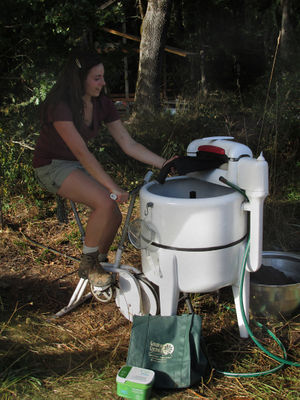
Pedal Powered Maytag Wringer Washer
IRONIC PROJECTS:
An element of historical irony can be introduced into a project by converting an antique device into an example of a more appropriate technology, thus demonstrating what could have been done long ago. (read below)
Example:
- Convert a 1940 Maytag Wringer Washer to mechanical pedal power. Think of it as a fun clean energy display that promotes regular exercise and demonstrates a design that the Maytag company could have employed over 70 years ago. By eliminating the electric motor drive, the Maytag Wringer, infamous for mangling entire arms (not to mention other body parts), has been tamed and made safe because the wringer roller assembly stops when you stop pedaling. This model wringer can be found by posting want adds on craigslist and using their search engine. A description can be found here. [6]
Sustainable Chemistry Projects
- Design and assemble an electrolytic cell for the electrolysis of Urine for generating hydrogen gas for use as fuel. Then power that electrolytic cell using a renewable energy source such as miro-hydo or photovoltaics. (Please consult with Bart or Lonny about safety precautions before proceeding.)
- Find the chemical formula and a non-toxic process to produce a moderate density structural closed cell bio-foam that is pour-able for casting radial paraboloids, uses water as a blowing agent if sprayed, does not require use of isocyanates, is recyclable, compostable and bio-compatible.
Artistic Projects
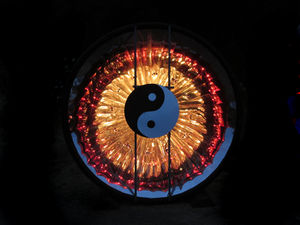
- Create an ethereal/psychedelic reflective LED light display that doubles as a parabolic solar cooker.
- Mold a 2' diameter ceramic paraboloid, surfaced with bits of salvaged glass mirror on its concave side.
- Weave a parabolic willow basket solar. Must be at least 4' in diameter. Surface with mirror finished 1 gallon can lids. [7] [8] [9]
WHAT IF... PROJECTS:
Please click on the PDF icon that appears at the top left area of the page that opens when you click on one of the links below.
REPLICATE A PAST PROJECT:
Repeating a past project is a opportunity to verify that a prototype actually works and can be built by others who follow the step by step procedures described on its Appropedia web page. It is a form of peer review which is an important part of scientific progress.
Examples:
- Convert a satellite dish into a solar popcorn popper. Please refer to: Aleiha's parabolic solar cooker and also solar cooker pg 3 html.htm
- Put together a 12volt pedal powered flat screen DVD player following the example procedure of this past project: CCAT pedal powered TV
RISQUE PROJECTS:
- Design and build The Vibracycle - A stationary, all-mechanical pedal powered exercise motivator. (Here are two design hints: 1) When driving long a lonely stretch of highway, take note, should your right side wheels happen to ride over the grated asphalt alert strip used to awaken those asleep at the wheel. 2) Study the design of the seat mount for this antique 1870's Victorian era high-wheel bicycle. [10])
NON-VIOLENT PEST CONTROL PROJECTS:
- Make home/indoor insect nets(alternative flyswatters)from stout steel wire hangers, splayed into net hoops fitted with green elf hat shaped nets(and then shipped to the Office of the Tibetan Government in Exile,(India)where the Dali Lama and his staff can use them around the office.)
- Design and build a rat powered radio and AA battery charger which classically conditions the rodent to run on a tread wheel connected to a generator in exchange for food via an automatic feeder; thus fostering a new era of inter-species cooperation.
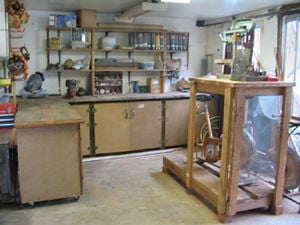
Future Projects:
- Restore the C.C.A.T Pedal Power Lab
- Establish a well tooled appropriate technology prototype fabrication Shop for A.T. 305 class projects.
- Establish a School Of Appropriate-Technology at Humboldt State University Now.
.
Consultations & Donations[edit | edit source]
- I like the old fashion tradition of students bringing the teacher an apple, both as a sign of gratitude and respect as well as providing needed sustenance. Each student working on a class project with me may offer a vegan food item at each meeting.
- Those students seeking private consultation with me are requested to ask their first question(s).... over lunch.
- Anyone wishing to help resupply needed items may choose from the following lists:
- Organic Food Ingredients for Solar Cooking and Pedal Powered Blender Demonstrations - canola oil, popcorn, sea salt, tamari, nutritional yeast, bread, cake flour, vanilla, tortillas, oatmeal, sugar, black beans, brown rice, potatoes and veggies etc.
- Citrisolve, mineral oil, safety sun glasses, Nature's Gate sunblock, mirror vinyl rolls, work gloves and paper towls made from recycled paper.
- Workshop space, storage space, land space
- Equipment: A foot operated shear for cutting sheet metal mirror, a Miller120 welder, a plasma-cutter
- Mirror finished aluminum or stainless steel sheet metal for use in fabricating parabolic solar cookers.
- A solar charged - battery powered - L.E.D. spot light
- Papasan Chairs Needed This Semester!
- Large Broken Glass Mirrors Needed This Semester!
- 1940 Maytag Wringer Washer Needed This Semester!
- I.R. Gun for measuring solar oven temperatures from a distance - Needed This Semester!
- Consultations with non-students on non-class related projects begin with a donation. The informational web sites I have created and listed may be accessed for free.
.
Contact[edit | edit source]
- Bart Orlando
- bart5691@gmail.com
- Mail Donations For Bart Orlando to this address - The First Community Credit Union P.O. Box 318 Cave Junction, Oregon 97523
- Donations can be made to fund Bart's appropriate technology projects at The Lost Valley Permaculture Education and Event Center where he instructs student interns how to design and build parabolic solar cookers and pedal powered tools and appliances. Here is a link to the Lost Valley Donation information webpage.
Past Student Projects[edit | edit source]
- Aleiha's parabolic solar cooker
- The Cobb Parabolic Solar Cooker
- Megan's bamboo umbrella solar cooker project
- The Sunbrella-umbrella solar cooker
- Stadium Light Solar Cookers
- The Papasan Chair Solar Cooker
- The Small Parabolic Cooker for Jefferson Community Center (A Papasan Chair Solar Cooker Project Spring Semester 2013)
- The Parabolic basket and tin can solar cooker
- The 8' diameter satellite dish solar cooker/popcorn popper
- Bicycle Trailer Fabrication
- Public Health Bike Blender
- CCAT pedal powered TV
- Willow Basket Parabolic Solar Cooker - A student intern permaculture project for the Lost Valley Education and Event Center
Links To More Detailed Information About My Work[edit | edit source]
- Pedal Powered Innovations by Bart Orlando
- CCAT Photos 1993-2003 by Bart Orlando Thank you K.J.
- Parabolic Solar Cooking
- Oregon Country Fair - Energy Park [11]
- Inappropriate Technology?
- Video of parabolic Solar Cooking demonstration at the Arcata Coop in 2007
- How to build a paraboloid Generate the diagram needed to build a paraboloid from a flat sheet given the distance from the vertex to the focus.

